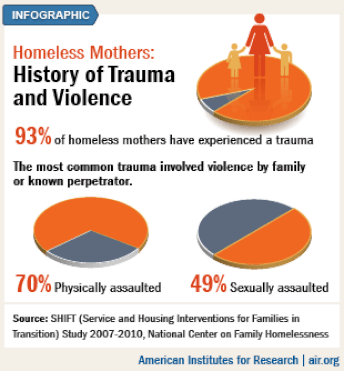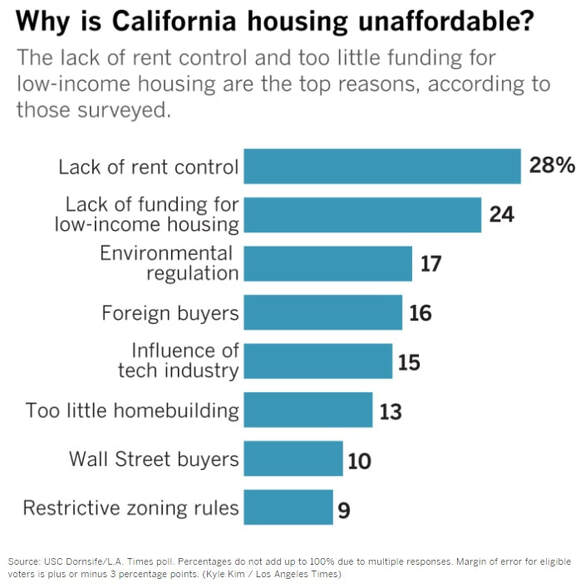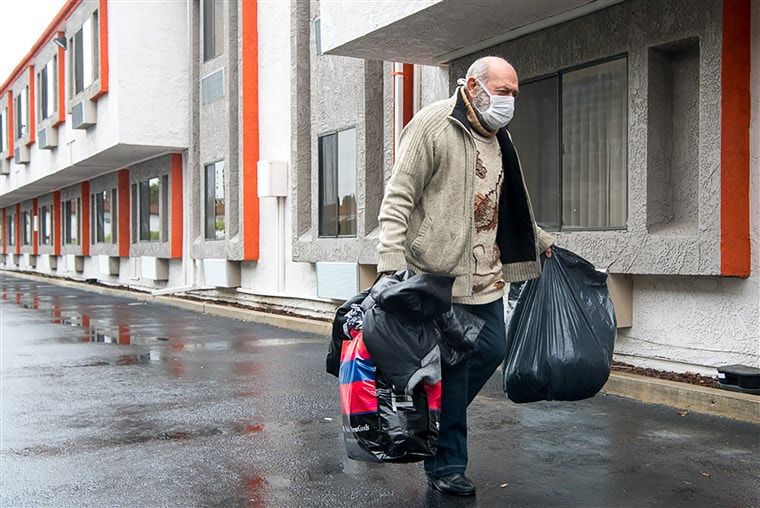The issue. |
Women, their abuse, and the housing crisis of Los Angeles.

In Los Angeles, the second city in the nation with the highest homeless encampments, one in three homeless people are now women. What we are dealing with is a crisis of the haves and the have-nots - a theme that holds true to the city of angels and its leaders current vision on the homeless emergency.
The streets are more dangerous for women. According to Homeless Hub, women on the street face higher rates of violence than women who are housed. Indigenous women are also over represented in the homeless population and are three times more likely to experience violence than their counterparts.
Central to the issue of female homelessness is the unfortunate theme that most of these women have histories of violence in their childhood and adult lives prior to losing housing. According to the American Institutes for Research infographic, 70% of homeless mothers have been physically assaulted in some capacity. With this harrowing information in mind, it becomes more evident why women fleeing violent/abusive relationships is a leading contributing factor to female homelessness.
When women end up on the streets, they are vulnerable to being re-victimized from harassment in combination with the violence and trauma that being homeless already brings on itself.
Much work needs to be done to create safe spaces for homeless women, including the need for female-only easily accessible emergency spaces to permanent housing units. It is equally important to acknowledge the systematic nature of violence in women's lives to create a culture where violence against women is unacceptable.
The streets are more dangerous for women. According to Homeless Hub, women on the street face higher rates of violence than women who are housed. Indigenous women are also over represented in the homeless population and are three times more likely to experience violence than their counterparts.
Central to the issue of female homelessness is the unfortunate theme that most of these women have histories of violence in their childhood and adult lives prior to losing housing. According to the American Institutes for Research infographic, 70% of homeless mothers have been physically assaulted in some capacity. With this harrowing information in mind, it becomes more evident why women fleeing violent/abusive relationships is a leading contributing factor to female homelessness.
When women end up on the streets, they are vulnerable to being re-victimized from harassment in combination with the violence and trauma that being homeless already brings on itself.
Much work needs to be done to create safe spaces for homeless women, including the need for female-only easily accessible emergency spaces to permanent housing units. It is equally important to acknowledge the systematic nature of violence in women's lives to create a culture where violence against women is unacceptable.
Why the city of Los Angeles is still a hub.
Typically when one thinks of the presence of the homelessness, we tend to picture urban areas first. Unlike New York, which has a higher population of homeless residents, Los Angeles’ homeless unsheltered rate is fifteen percent higher. Only five percent of the homeless population is unsheltered in the Big Apple. So what is the larger issue at play here? For a state with such a booming economy and unparalleled access to resources and funding, why are we so complacent with people living on the streets?
According to Nithya Raman, a member of the Democratic Socialists of America who is currently running for city council in Los Angeles, more homeless individuals are dying in Los Angeles than in New York. Raman was interviewed by Will Menaker of the “Chapo Trap House,” a political and humor podcast, during which she answered that three homeless individuals die daily from exposure to two main killers: exposure from the elements due to lack of shelter, and brutality from the LAPD.
These people are being vulnerable to the deficient systems we have set up to respond to issues of homelessness. She believes that the city outcasts those who are of a lower-income status because they are not able to contribute to the economy. Raman has made it her mission to spread a message of acceptance and community.
Historically, Raman feels that politicians have been able to ignore the issue of homelessness because for many years, these vulnerable individuals were primarily living in Skid Row, along the streets of Hollywood, and near the beaches. However, now that the issue is progressing at a rapid rate, encampments have now grown in every neighborhood in the city, becoming an issue that is unignorable in Los Angeles.
While working at city hall in 2014, Raman experienced first hand that the city was spending millions of dollars on homelessness in terms of putting them in jail for three nights and then releasing them - moving these individuals around from place to place. Ultimately, Raman feels that there is an unforgiving gap between the rhetoric the politicians use in regard to the homeless crisis and the reality of people’s experience of homelessness.
According to the last census count outlined in the Los Angeles Times, close to 59,000 people - roughly the population of Cupertino, California - lacked permanent housing across LA County. This figure is up by 16% from last year, and growing. Most of those living outside are deteriorating quickly, with more than ever afflicted by drug addiction, mental illness, and physical limitations. Moreover, this past year was supposed to be the year of solutions - the first shelters to be funded by a $1.2-billion city bond measure titled “HHH” is continuing to be delayed. About 150 people become homeless in L.A. County every day.
Our city is simply failing at the housing market. It is determining who gets to live here, who has to move, and who is being phased out. We are seeing a transformation of Los Angeles as a result of the housing crisis. When rent goes up by 5%, another 2,000 people become homeless. Compared to 175,000 public housing units in New York, Los Angeles has less than 10,000. Given 51 city council members, Los Angeles has 15. In terms of rent, the city of New York has enacted rent control, Los Angeles operates using a very flexible rent stabilization ordinance.
Our city needs to do better. This starts with the election of competent officials that have a true concern for the needs and well being of the people.
Breaking news - COVID-19 pandemic challenges for the homeless:
Typically when one thinks of the presence of the homelessness, we tend to picture urban areas first. Unlike New York, which has a higher population of homeless residents, Los Angeles’ homeless unsheltered rate is fifteen percent higher. Only five percent of the homeless population is unsheltered in the Big Apple. So what is the larger issue at play here? For a state with such a booming economy and unparalleled access to resources and funding, why are we so complacent with people living on the streets?
According to Nithya Raman, a member of the Democratic Socialists of America who is currently running for city council in Los Angeles, more homeless individuals are dying in Los Angeles than in New York. Raman was interviewed by Will Menaker of the “Chapo Trap House,” a political and humor podcast, during which she answered that three homeless individuals die daily from exposure to two main killers: exposure from the elements due to lack of shelter, and brutality from the LAPD.
These people are being vulnerable to the deficient systems we have set up to respond to issues of homelessness. She believes that the city outcasts those who are of a lower-income status because they are not able to contribute to the economy. Raman has made it her mission to spread a message of acceptance and community.
Historically, Raman feels that politicians have been able to ignore the issue of homelessness because for many years, these vulnerable individuals were primarily living in Skid Row, along the streets of Hollywood, and near the beaches. However, now that the issue is progressing at a rapid rate, encampments have now grown in every neighborhood in the city, becoming an issue that is unignorable in Los Angeles.
While working at city hall in 2014, Raman experienced first hand that the city was spending millions of dollars on homelessness in terms of putting them in jail for three nights and then releasing them - moving these individuals around from place to place. Ultimately, Raman feels that there is an unforgiving gap between the rhetoric the politicians use in regard to the homeless crisis and the reality of people’s experience of homelessness.
According to the last census count outlined in the Los Angeles Times, close to 59,000 people - roughly the population of Cupertino, California - lacked permanent housing across LA County. This figure is up by 16% from last year, and growing. Most of those living outside are deteriorating quickly, with more than ever afflicted by drug addiction, mental illness, and physical limitations. Moreover, this past year was supposed to be the year of solutions - the first shelters to be funded by a $1.2-billion city bond measure titled “HHH” is continuing to be delayed. About 150 people become homeless in L.A. County every day.
Our city is simply failing at the housing market. It is determining who gets to live here, who has to move, and who is being phased out. We are seeing a transformation of Los Angeles as a result of the housing crisis. When rent goes up by 5%, another 2,000 people become homeless. Compared to 175,000 public housing units in New York, Los Angeles has less than 10,000. Given 51 city council members, Los Angeles has 15. In terms of rent, the city of New York has enacted rent control, Los Angeles operates using a very flexible rent stabilization ordinance.
Our city needs to do better. This starts with the election of competent officials that have a true concern for the needs and well being of the people.
Breaking news - COVID-19 pandemic challenges for the homeless:
Sickness, illness, and disease also heavily impact and cause further distress to the impoverished communities. The rapid spread of the novel COVID-19 virus pandemic is leaving the already vulnerable homeless population in even worse condition.
Because many homeless individuals also live in encampments in close proximity to each other where personal hygiene is poor or non-existent, the virus is able to easily spread. They are not able to successfully practice social distancing and quarantining as recommended by the Centers for Disease Control - many live piled together in large shelters. Furthermore, they are being thrown out of their shelters at the first sign of illness, albeit an ongoing cough or sneeze.
Several also lack access to the media or any form of technology, so they may even be unaware of COVID-19’s contagious nature or existence of the virus itself. Additionally, the fact that individuals may be carriers of the virus while also being asymptomatic is distressing because they may believe everything is fine while still carrying the virus. These individuals lack the funds to get tested for the virus, to be seen by a healthcare practitioner, to purchase medicine. They are not afforded even the basic necessities to be able to prevent themselves from contracting the virus and spreading it around their community.
California governor Gavin Newsom estimates up to 60,000 homeless could end up infected. However, there is only one confirmed death of a homeless person in California so far. Newsom said the person died in Santa Clara County, just south of San Francisco. Many of the homeless are also faced with unsanitary and inhumane conditions that put them further at risk of death amid the spread of the corona-virus.
The residents of shelters in Orange County are reporting a variety of serious issues, including empty soap dispensers, a lack of toilet paper, and no hot water combined with infrequent cleaning. With California cities such as Anaheim enacting a number of anti-homeless laws, several face the potential consequence of arrest or harassment should they choose to leave the unsanitary shelter.
Fortunately, many city council members are exploring the possibility of turning business centers into interim or permanent housing for the homeless, such as the closed St. Vincent Medical Center. Though California’s governor is also working to transform hotels and trailers into available spaces to house the homeless, until this transition happens, many shelter residents are left facing serious illness as shelters across the city begin preparing for lock downs.
Because many homeless individuals also live in encampments in close proximity to each other where personal hygiene is poor or non-existent, the virus is able to easily spread. They are not able to successfully practice social distancing and quarantining as recommended by the Centers for Disease Control - many live piled together in large shelters. Furthermore, they are being thrown out of their shelters at the first sign of illness, albeit an ongoing cough or sneeze.
Several also lack access to the media or any form of technology, so they may even be unaware of COVID-19’s contagious nature or existence of the virus itself. Additionally, the fact that individuals may be carriers of the virus while also being asymptomatic is distressing because they may believe everything is fine while still carrying the virus. These individuals lack the funds to get tested for the virus, to be seen by a healthcare practitioner, to purchase medicine. They are not afforded even the basic necessities to be able to prevent themselves from contracting the virus and spreading it around their community.
California governor Gavin Newsom estimates up to 60,000 homeless could end up infected. However, there is only one confirmed death of a homeless person in California so far. Newsom said the person died in Santa Clara County, just south of San Francisco. Many of the homeless are also faced with unsanitary and inhumane conditions that put them further at risk of death amid the spread of the corona-virus.
The residents of shelters in Orange County are reporting a variety of serious issues, including empty soap dispensers, a lack of toilet paper, and no hot water combined with infrequent cleaning. With California cities such as Anaheim enacting a number of anti-homeless laws, several face the potential consequence of arrest or harassment should they choose to leave the unsanitary shelter.
Fortunately, many city council members are exploring the possibility of turning business centers into interim or permanent housing for the homeless, such as the closed St. Vincent Medical Center. Though California’s governor is also working to transform hotels and trailers into available spaces to house the homeless, until this transition happens, many shelter residents are left facing serious illness as shelters across the city begin preparing for lock downs.


